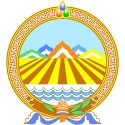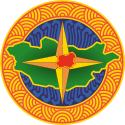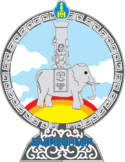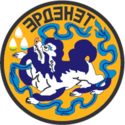Mongoliets provinser

Mongoliet er opdelt i 21 provinser (mongolsk: аймаг ajmag). Hver provins er opdelt i flere distrikter (mongolsk: сум sum ). Ordet ajmag kommer fra "stammen" i det mongolske sprog og i det tyrkiske. De moderne provinser har eksisteret siden 1921. Nationens hovedstad Ulan Bator er reguleret som en selvstændig kommune adskilt fra Töv, der omslutter hovedstaden.
Provinser
| Våben | Provins | Mongolsk (kyrillisk) | Mongolsk (mongolsk) | Distrikter | Befolkning[1] | Areal (km²) | Bef.tæt. | Hovedstad |
|---|---|---|---|---|---|---|---|---|
 | Arkhangaj | Архангай | ᠠᠷᠤᠬᠠᠩᠭᠠᠢ | 19 | 84.584 | 55.313,82 | 1,53 | Tsetserleg |
 | Bajan-Ölgij | Баян-Өлгий | ᠪᠠᠶᠠᠨ ᠥᠯᠦᠭᠡᠢ | 13 | 88.056 | 45.704,89 | 1,93 | Ölgij |
 | Bajankhongor | Баянхонгор | ᠪᠠᠶᠠᠩᠬᠣᠩᠭᠣᠷ | 20 | 76.085 | 115.977,80 | 0,66 | Bajankhongor |
 | Bulgan | Булган | ᠪᠤᠯᠠᠭᠠᠨ | 16 | 53.655 | 48.733 | 1,10 | Bulgan |
 | Darkhan-Uul | Дархан-Уул | ᠳᠠᠷᠬᠠᠨ ᠠᠭᠤᠯᠠ | 4 | 94.625 | 3.275,00 | 28,89 | Darkhan |
 | Dornod | Дорнод | ᠳᠣᠷᠤᠨᠠᠳᠤ | 14 | 69.552 | 123.597,43 | 0,56 | Tsjojbalsan |
 | Dornogov | Дорноговь | ᠳᠣᠷᠤᠨᠠᠭᠣᠪᠢ | 14 | 58.612 | 109.472,30 | 0,54 | Sajnsjand |
 | Dundgov | Дундговь | ᠳᠤᠮᠳᠠᠭᠣᠪᠢ | 15 | 38.821 | 74.690,32 | 0,52 | Mandal-Gov |
 | Gov-Altaj | Говь-Алтай | ᠭᠣᠪᠢ ᠠᠯᠲᠠᠢ | 18 | 53.590 | 141.447,67 | 0,38 | Altaj |
 | Gov-Sümber | Говь-Сүмбэр | ᠭᠣᠪᠢ ᠰᠦᠮᠪᠦᠷ | 3 | 13.240 | 5.541,80 | 2,39 | Tsjojr |
 | Khentij | Хэнтий | ᠺᠡᠨᠲᠡᠢ | 17 | 65.811 | 80.325,08 | 0,82 | Öndörkhaan |
 | Khovd | Ховд | ᠬᠣᠪᠲᠤ | 17 | 76.870 | 76.060,38 | 1,01 | Khovd |
 | Khövsgöl | Хөвсгөл | ᠺᠥᠪᠰᠦᠭᠦᠯ | 23 | 114.926 | 100.628,82 | 1,14 | Mörön |
 | Ömnögov | Өмнөговь | ᠡᠮᠦᠨᠡᠭᠣᠪᠢ | 15 | 61.314 | 164.380,47 | 0,37 | Dalanzadgad |
 | Orchon | Орхон | ᠣᠷᠬᠣᠨ | 2 | 90.700 | 844,00 | 107,46 | Erdenet |
 | Övörkhangaj | Өвөрхангай | ᠥᠪᠦᠷᠬᠠᠩᠭᠠᠢ | 19 | 101.314 | 62.895,33 | 1,61 | Arvajkheer |
 | Selenge | Сэлэнгэ | ᠰᠡᠯᠡᠩᠭᠡ | 17 | 97.858 | 41.152,63 | 2,37 | Sükhbaatar |
 | Sükhbaatar | Сүхбаатар | ᠰᠦᠺᠡᠪᠠᠭᠠᠲᠤᠷ | 13 | 51.334 | 82.287,15 | 0,62 | Baruun-Urt |
 | Töv | Төв | ᠲᠥᠪ | 27 | 85.166 | 74.042,37 | 1,15 | Zuunmod |
 | Uvs | Увс | ᠤᠪᠰᠤ | 19 | 73.323 | 69.585,39 | 1,05 | Ulaangom |
 | Zavkhan | Завхан | ᠵᠠᠪᠬᠠᠨ | 24 | 65.481 | 82.455,66 | 0,79 | Uliastaj |
 | Ulan Bator | Улаанбаатар | ᠤᠯᠠᠭᠠᠨᠪᠠᠭᠠᠲᠤᠷ | 9 | 1.154.290 | 4.704,40 | 226,90 | Ulan Bator |
Referencer
- ^ Folketælling 10. november 2010: The 2010 Population and Housing Census of Mongolia
|
Medier brugt på denne side
Coat of Arms of the Selenge Aimag in Mongolia, from 1999.
Official blason, from the resolution no. 40 of 1999-12-24 by the aimag khural:
- At the basis, an upright conch shell horn
- Wrapped in a khadag
- Flanked by evergreen leaves
- The Mountains of Khan-Uul in the background
- Fields in the middle
- Stylized waves of the Selenge river at the bottom
- A circular enclosure with crossing meanders
- Crowned by the three wish fullfilling jewels
Coat of Arms of Töv Aimag in Mongolia.
No formal blason found.
- A yellow/orange circle with a pattern of overlapping partial disks
- A dark blue background with a different pattern
- The outline of the map of Mongolia in green
- In front of that, a 4-armed star
- In front of that, the outline of the map of Töv Aimag in red
Coat of Arms of Ömnögovi Aimag, Mongolia, since 2011.
Decision No 17 of the Aimag Khural of 2011-03-17: http://omnogovi.khural.mn/m/j3ky
- At the top a Chandmani (wishfullfilling jewel) in the colors "copper", "gold", and "coal"
- A crossing meander in gold around the circumference
- The blue of the eternal sky
- The three peaks of the Gurvan Saikhan mountain range
- Sand dunes and camel in sand colors
- A blue khadag with the white text "Ömnögovi" in cyrillic script
- A green field
Coat of arms of Uvs Aimag, Mongolia, since 1999.
Official blason, installed by the Aimag Khural in decision No. 9 on 1999-12-21: http://uvs.khural.mn/m/fbko
- Circular shape, representing the circle of life and the path of the earth around the sun
- The upper half of the circle is blue to symbolize the protection of health
- At the very top three tongued flame, sun, and moon show the advancement of the future
- The outline of an inner red circle for the aimag center Ulaangom
- On the lower half of the circle, on a yellow background in dark brown color the icons:
- A horse for livestock
- A barley grain spike for agriculture
- A cog wheel for industry
- Inside the circle on green background the name of Uvs Aimag in bold letters (in our case in traditional Mongolian script)
- In the center of the circle brown and yellow sand dunes
- Behind the dunes white and blue waves for the aimags lakes
- Behind the lake, a snow capped mountain
- The mountain peak has a double meaning:
- A flying white falcon
- The top cover of a Mongolian yurt
Coat of Arms of Darkhan-Uul Aymag (Province) in Mongolia.
Formally, this is the emblem of the City of Darkhan.
Approved in Resolution No. 95 of 1974 by the "People's Deputies".
- Interlocked rings for friendship, as a symbol of the city
- Statements about sovjet brothers and socialist community that don't make much sense anymore today
Coat of Arms of Khövsgöl Aimag in Mongolia; Established 2014
Forfatter/Opretter: ulsuud@yahoo.com, Licens: CC BY-SA 3.0
Coat of arms of Bayankhongor Aymag, Mongolia
Coat of Arms of Dundgovi Aimag in Mongolia.
Coat of arms of Khovd Aymag, Mongolia; since 2014
Coat of Arms of Dornod Aimag in Mongolia, version of 2001.
No officially published blason found, only one published by a third party: http://www.choibalsan.mn/index.php?newsid=689
- A red rising sun rising from under the foot of...
- A running gazelle
- The letters "Dornod" in cyrillic script
- The waves of the Kherlen river
- A blue base for the untouched steppe
- A golden yellow circle outline
Coat of Arms of Övörkhangai Aimag in Mongolia.
No official blason found.
- Based on a lotos
- Base wrapped in a khadag, two small garlands at the top
- Main piece is the great Stupa of Erdene Zuu
- A crossed Vajra in front
- The name Övörkhangai, left in folded style Mongolian script, right in Soyombo script
- All parts above the base in a curved frame as commonly used in devotional displays.
Coat of Arms of Govi-Altai Aimag, Mongolia, since 2011.
Official blason: http://www.govi-altai.gov.mn/blog/list/17
- Based on a lotos.
- Enclosed in a circular meander pattern
- In the center a leaping Argali-sheep, stands for wealth of wildlife
- Green background at the bottom
- Yellow background in the middle
- High majestic mountains of Govi-Khangai above
- Blue background at top for the eternal sky
- Global information and communication technologies are symbolized by circular wave-fronts emanating from the bottom
- At the very top the silhouette of a book pays hommage to science education
- In front, a golden soyombo for Mongolian indepence
- Near the base a gear wheel for industry
- Flanked by corn spikes for agriculture
- The bottom is wrapped in a banner with the text "Govi-Altai" in cyrillic letters
Coat of arms of Sükhbaatar Aimag, Mongolia.
No official blason found. Real life examples show the following elements:
- The background probably symbolizes a lotos as seen from above, with green leaves and yellow/white petals, point-symmetrical over 4 axes.
- The outline in blue, in a floral line pattern.
- Centered over this a red square
- Centered within the red a blue square
- In the blue field, a wind horse (khiimöri), with wings made of flames in the three colors white, red, yellow.
- On the remaining red "frame", the words "Sükhbaatar Aimag" in cyrillic characters horizontally, and in folded style Mongolian script vertically.
Coat of Arms of Dornogovi Aimag in Mongolia. Introduced by Resolution No. 01 of 2011 by the Aimag Khural.
Coat of arms of Bayan-Ölgii Aimag in Mongolia.
Official Blason and example: http://bayan-olgii.khural.mn/m/9h5o
- An eagle with wings spread open as symbol of courage and freedom
- Each of the wings has 12 feathers
- A golden crown (toono) of a kazakh yurt, home of the nomadic people
- Seen through that, the eternal blue sky and a golden sun
- The ring of the toono is made from the two horns of an ibex as a sign of eternal sturdyness
- On top a golden soyombo, the national symbol of Mongolia
- On the eagles chest
- The peaks of Altai Tavan Bogd mountain
- A "curly pattern" representing regional folk craft
- The shield of a hero
- A book, symbolizing wisdom
- Framed by two spikes of grain, the source of life
- and two heart-shaped fire balls
- Under the talons of the eagle a banner with the colors of the aimag flag inscribed with the name "Bayan-Ölgii" in cyrillic letters
Mongolia aimag division map, German version
Coat of Arms of Govisümber Aimag, Mongolia.
Official blason: http://govisumber.gov.mn/?page_id=241
- Under a clear sky
- Blueish Gurvan saikhan mountain range, representing past, present and future
- Sun and moon for prosperity
- In the center in white color the word "Choir" in folded style Mongolian script
- The yellow lion is a symbol of the province
- The lion wears a collar with a gem, showing that it is tamed
Coat of arms of Erdenet city, Mongolia
Coat of Arms of Khentii Aimag in Mongolia.
Coat of Arms of Zavkhan Aimag in Mongolia
No official blason found.
- A cross-vajra, symbol of steadyness
- Otgontenger Mountain with its snow cap
- A strip of each sand color, green, blue, and brown
- Two white flowers with yellow center
Coat of Arms of Arkhangai Aimag in Mongolia.
It starts to appear on photographs in 2014, so it was probably introduced that year.
No official blason found.
- Taikhar Chuluu (pituresqe rock)
- Khorgo (extinct volcano)
- A Yak
- A monastery building
- A body of water
- In the water(?), a deer reminiscent of those found on prehistoric stone carvings, with its antlers forming the distorted numerals "1923".
- Green leaves
- The name "Arkhangai" in cyrillic letters
- A circular frame with crossing meanders
- Based on a lotos
- A three-tongued flame on top
Coat of Arms of Bulgan Aimag in Mongolia.























